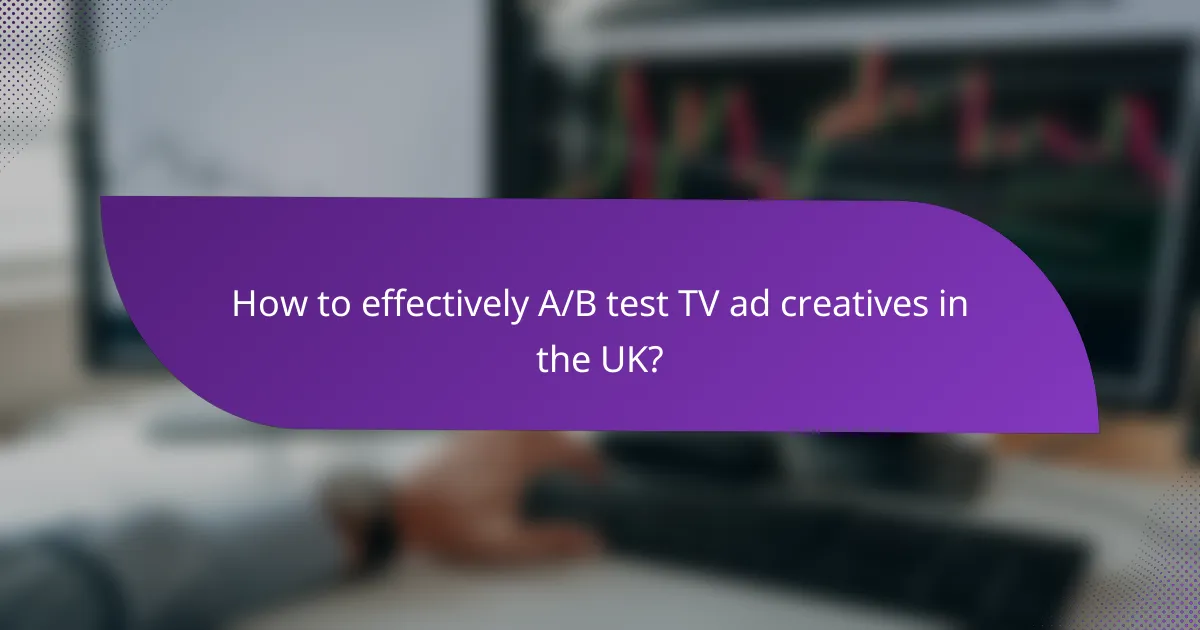A/B testing TV ad creatives is a crucial strategy for optimizing marketing efforts and enhancing viewer engagement. By establishing clear goals and metrics, advertisers can effectively compare different ad versions to identify which resonates best with audiences. Implementing best practices and tracking key performance metrics will ensure that the insights gained lead to improved ad effectiveness and higher conversion rates.

How to effectively A/B test TV ad creatives in the UK?
To effectively A/B test TV ad creatives in the UK, start by establishing clear goals and metrics that align with your marketing objectives. This process involves comparing two or more versions of an ad to determine which performs better in terms of viewer engagement and conversion rates.
Define clear objectives
Defining clear objectives is crucial for successful A/B testing of TV ad creatives. Objectives should be specific, measurable, achievable, relevant, and time-bound (SMART). For instance, you might aim to increase brand awareness by a certain percentage or drive a specific number of website visits within a month.
Having well-defined objectives helps in designing the test and ensures that all stakeholders understand what success looks like. This clarity also aids in focusing the creative elements that will be tested, such as messaging, visuals, or calls to action.
Choose appropriate metrics
Selecting the right metrics is essential to evaluate the performance of your TV ad creatives. Common metrics include reach, frequency, engagement rates, and conversion rates. For example, you might track how many viewers visit your website after seeing the ad or how many engage with your social media channels.
Consider using both quantitative metrics, like sales figures, and qualitative metrics, such as viewer sentiment. This balanced approach provides a comprehensive view of how well each creative performs against your objectives.
Segment your audience
Segmenting your audience allows for more targeted A/B testing of TV ad creatives. By dividing your audience based on demographics, viewing habits, or purchasing behavior, you can tailor your ads to resonate more effectively with each group. For example, younger viewers might respond better to a more dynamic ad style compared to older demographics.
Using audience segmentation helps in understanding which creative elements work best for different groups, leading to more effective advertising strategies and improved ROI.
Utilize A/B testing tools
Utilizing A/B testing tools can streamline the process of testing TV ad creatives. Various platforms offer features to manage and analyze A/B tests, such as tracking viewer responses and engagement across different channels. Tools like Nielsen or Kantar can provide insights into audience reactions and ad performance.
These tools often come with built-in analytics that help in comparing the performance of different creatives, making it easier to draw actionable conclusions from your tests.
Analyze results thoroughly
Thorough analysis of results is vital to understand the effectiveness of your A/B tests. After running the tests, review the data collected against your predefined metrics and objectives. Look for trends and patterns that indicate which creative performed better and why.
Consider conducting follow-up surveys or focus groups to gain deeper insights into viewer perceptions. This qualitative data can complement your quantitative findings and provide a fuller picture of your ad’s impact.

What are the best practices for A/B testing TV ads?
The best practices for A/B testing TV ads involve systematic approaches to ensure reliable results. Focus on testing specific elements, using adequate sample sizes, and allowing enough time for the tests to yield meaningful insights.
Test one variable at a time
Testing one variable at a time is crucial for isolating the effects of each change in your TV ad. For instance, if you alter both the script and the visuals simultaneously, it becomes challenging to determine which change drove viewer response. Stick to one element, such as the call-to-action or the music, to clearly assess its impact.
By narrowing your focus, you can draw more accurate conclusions and make informed decisions for future campaigns. This method reduces confusion and enhances the clarity of your findings.
Use a representative sample size
Using a representative sample size is essential for obtaining valid results from your A/B tests. A sample that reflects your target audience ensures that the insights you gather are applicable to the broader market. Aim for a sample size that is large enough to account for variations in viewer behavior, typically in the low thousands for significant results.
Too small a sample may lead to misleading conclusions, while an excessively large sample can waste resources. Balance is key; consider factors like your budget and the expected reach of the ad when determining the sample size.
Run tests for sufficient duration
Running tests for a sufficient duration allows you to capture a complete picture of viewer engagement and response. A/B tests should ideally run for several weeks to account for variations in viewing habits and to ensure that results are not skewed by short-term trends. This duration helps in understanding how different ads perform over time.
Monitor key performance metrics consistently throughout the testing period. Avoid making hasty decisions based on preliminary data; wait for the test to conclude to ensure that your insights are robust and reliable.

What performance metrics should be tracked?
Tracking performance metrics is essential for evaluating the effectiveness of A/B testing in TV ad creatives. Key metrics include viewership ratings, engagement levels, conversion rates, and cost per acquisition, each providing insights into different aspects of ad performance.
Viewership ratings
Viewership ratings indicate how many people watched your ad during its airing. This metric is crucial as it helps assess the reach of your campaign and can be measured through services like Nielsen ratings. Aim for ratings that are above average for your target demographic to ensure your ad is being seen.
Consider comparing ratings across different ad creatives to identify which version resonates more with viewers. A significant difference in ratings can guide future creative decisions and media placements.
Engagement levels
Engagement levels measure how viewers interact with your ad, including actions like visiting your website or searching for your product after seeing the ad. High engagement indicates that your ad is capturing attention and prompting viewers to take action. Use tools like social media metrics or website analytics to track these interactions.
To enhance engagement, focus on creating compelling content that encourages viewers to respond. Avoid overly complex messages that may confuse or disengage your audience.
Conversion rates
Conversion rates reflect the percentage of viewers who take a desired action, such as making a purchase or signing up for a newsletter, after seeing your ad. This metric is vital for understanding the effectiveness of your ad in driving sales or leads. A good conversion rate typically ranges from 1% to 5%, depending on the industry.
To improve conversion rates, ensure that your ad includes a clear call to action and aligns with the landing page experience. Test different creatives to see which versions lead to higher conversions.
Cost per acquisition
Cost per acquisition (CPA) measures the total cost associated with acquiring a customer through your ad campaign. This metric is crucial for assessing the financial efficiency of your advertising efforts. A lower CPA indicates a more effective campaign, while a higher CPA may signal the need for adjustments in targeting or creative strategy.
To optimize CPA, analyze the costs associated with different ad placements and creatives. Focus on channels that yield the best return on investment, and consider reallocating budget towards higher-performing ads.

What are common challenges in A/B testing TV ads?
A/B testing TV ads presents several challenges that can hinder effective evaluation and optimization. Key issues include limited audience reach, high costs of ad placements, and difficulty in measuring impact, all of which require careful consideration to achieve meaningful results.
Limited audience reach
One significant challenge in A/B testing TV ads is the limited audience reach, which can skew results. Unlike digital platforms, where targeting can be precise, TV ads often broadcast to a broad audience, making it hard to isolate the effects of different creatives.
To mitigate this, consider testing ads during specific time slots or programs that align with your target demographic. This can enhance the likelihood of reaching the desired audience and provide more reliable data for analysis.
High costs of ad placements
The high costs associated with TV ad placements can make A/B testing financially prohibitive. Running multiple versions of an ad requires significant investment, especially during prime time or popular shows, which may not yield a proportional increase in insights.
To manage costs, prioritize testing a small number of creatives that represent different messaging or visuals. This approach allows for effective comparison without overwhelming your budget. Additionally, consider using regional broadcasts to test ads at a lower cost before a national rollout.
Difficulty in measuring impact
Measuring the impact of A/B tested TV ads can be complex due to the lack of immediate feedback mechanisms. Unlike online ads, where clicks and conversions can be tracked in real-time, TV ads often require longer-term metrics to assess effectiveness.
Utilize methods such as post-campaign surveys, brand lift studies, or sales data analysis to gauge the impact of different ad versions. Setting clear KPIs before the campaign can also help in evaluating performance and making informed decisions for future ads.

How to select the right A/B testing tool for TV ads?
Selecting the right A/B testing tool for TV ads involves considering integration capabilities, reporting features, and user-friendliness. The ideal tool should seamlessly fit into your existing workflow, provide insightful analytics, and be easy for your team to use.
Evaluate integration capabilities
When choosing an A/B testing tool, assess how well it integrates with your current advertising platforms and data sources. A tool that connects with your media buying software or customer relationship management (CRM) system can streamline your workflow and enhance data accuracy.
Look for tools that support APIs or have pre-built integrations with popular platforms. This can save time and reduce errors when transferring data between systems.
Assess reporting features
Robust reporting features are crucial for understanding the performance of your TV ad creatives. The right tool should offer customizable dashboards, real-time analytics, and the ability to track key performance indicators (KPIs) such as viewer engagement and conversion rates.
Consider tools that allow you to visualize data through charts and graphs, making it easier to interpret results and share insights with your team. Look for options that can generate automated reports to keep stakeholders informed.
Consider user-friendliness
User-friendliness is essential for ensuring that your team can effectively utilize the A/B testing tool. A tool with an intuitive interface will require less training and reduce the likelihood of user errors.
Test the tool with a trial version if available, focusing on how easily you can set up tests, analyze results, and make adjustments. A good user experience can significantly enhance the efficiency of your A/B testing process.

What insights can be gained from A/B testing TV ad creatives?
A/B testing TV ad creatives provides valuable insights into audience preferences and ad effectiveness. By comparing different versions of an ad, marketers can identify which elements resonate best with viewers, leading to improved engagement and conversion rates.
Understanding audience preferences
A/B testing allows advertisers to gauge which creative elements appeal most to their target demographic. This can include variations in visuals, messaging, or calls to action. For instance, an ad featuring a celebrity endorsement may perform better than one without, revealing audience inclinations.
By analyzing viewer responses, brands can tailor future campaigns to align with audience tastes. This targeted approach often results in higher viewer retention and brand loyalty.
Measuring ad performance
Performance metrics from A/B testing can include viewer engagement rates, recall, and conversion rates. For example, if one ad version leads to a significantly higher website visit rate, it indicates stronger effectiveness. Tracking these metrics helps in understanding the overall impact of the ad on sales and brand perception.
Using tools like Nielsen ratings or digital analytics can provide a comprehensive view of how each ad performs across different platforms, allowing for more informed decisions in future campaigns.
Optimizing future campaigns
Insights gained from A/B testing can directly inform the optimization of future ad campaigns. By identifying successful elements, marketers can replicate these in new ads, enhancing overall effectiveness. For example, if a specific color scheme or tagline consistently performs well, it should be integrated into future creatives.
Additionally, it’s crucial to continuously test and iterate. The advertising landscape is dynamic, and what works today may not resonate tomorrow. Regular A/B testing ensures that campaigns remain relevant and impactful.